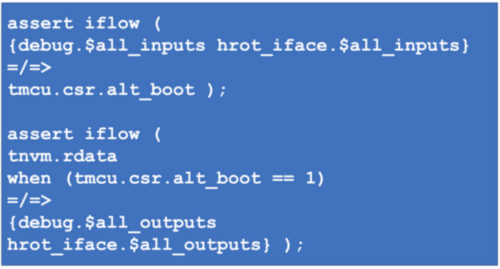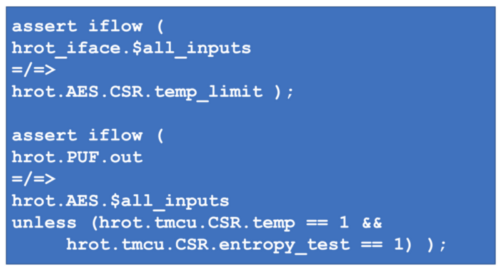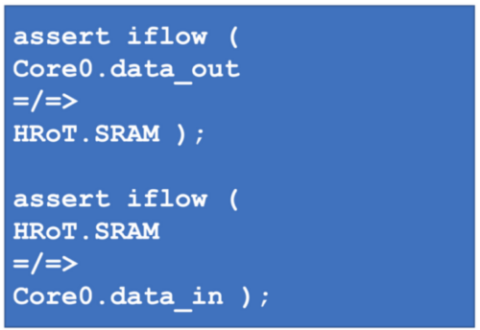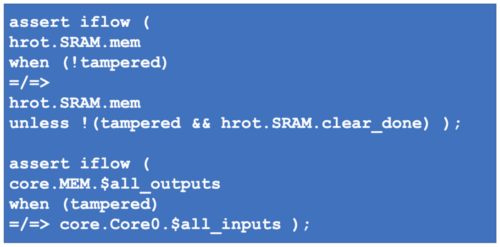Whether you’re just starting to build out a hardware security program at your organization, or you’re looking to optimize existing hardware security processes, the MITRE Common Weakness Enumeration (CWE) database is an excellent resource to keep in your toolbox.
What is CWE?
A CWE is a weakness, or flaw, in the design of either hardware or software in embedded systems that may lead to a security vulnerability. A vulnerability is weakness that can be exploited by a malicious actor to compromise the security of a system. The CWE list enumerates over 100 weaknesses that may be present in your design. The MITRE Common Vulnerabilities and Exposures (CVE) database is a list of actual security vulnerabilities, and they are often enabled by weaknesses listed in the CWE database. For example, the Spectre and Meltdown vulnerabilities are possible due to the underlying weakness (CWE-1303) “Non-Transparent Sharing of Microarchitectural Resources”. The CWE database is a community-developed list, but it is managed and maintained by the MITRE Corporation.
I’ve written previously about how the process of information flow checking, which is the process of automatically tracking information about secure assets through logical and sequential transformations through the hardware design. The process of identifying security requirements and translating them to verifiable rules can be leveraged with the CWE database. It is a way to verify that you don’t have the weaknesses listed in the CWE database in your design.
For the purposes of this blog, let’s take a detailed look at four different hardware CWEs and how you can translate them to security rules which you can include in your simulation or emulation regression runs in your hardware security program.
CWE-1277: Firmware Not Updateable
CWE-1277 happens when a product’s firmware cannot be updated or patched. This leaves systems vulnerable to attack, as potential weaknesses in the firmware have no means of repair and can be exploited by bad actors.
Depending on the actual design implementation there may be several vulnerabilities related to this CWE to verify. If the design doesn’t have the ability to patch ROM code, this could simply be an implementation oversight, or it could be intentional.
Security verification will not find this type of vulnerability if something is missing that only exists in documentation. However, it will find cases where there are security violations caused by an incorrect implementation or design.
Let’s consider the circumstance where the implemented update mechanism can be bypassed. This case can be modeled as an information flow verification problem.
For this example, consider a hypothetical SoC, illustrated below:

The Trusted Microcontroller Unit (tmcu) in the Hardware Root of Trust (HRoT) loads firmware from the ROM in the HRoT. The ROM is programmed during manufacturing and cannot be changed. To provide a method to update the firmware, new firmware can be written to the trusted non-volatile memory (tnvm) and a bit set in the tmcu will instruct it to read firmware from a predetermined address in tnvm instead.
Threat Model
An attacker may be able to read the modified firmware and later write back malicious code to the tnvm. The attacker may also clear the control bit in the tnvm so that the device falls back to executing old firmware which may have known security vulnerabilities and thereby enabling further attacks.
Security Requirement
The tmcu register controlling firmware location must not be writable from outside the HRoT. The updated firmware must not be readable or writable from outside the HRoT when it is being used by the tmcu.
Now, let’s take a look at how Cycuity’s Radix technology can detect and prevent vulnerabilities caused by weaknesses described in CWE-1277, enforcing these security requirements.
Radix Security Rules
The requirements can be expressed as information flow verification problems i.e.:
- Information (e.g. write data) from outside the HRoT must not flow to the alternative boot register
- Information (e.g. read data) from the tnvm must not flow outside the HRoT
Using the Radix no-flow operator “=/=>” we can write the following security rules

Verification of the security requirement
Using the security rules above, Cycuity’s Radix tool will build a security monitor which when simulated together with the design will flag any violations of the rules.
CWE-1351: Improper Handling of Hardware Behavior in Exceptionally Cold Environments
CWE-1351 happens when a hardware device, or the firmware running on that device, has incorrect or missing protection features that maintain the goals of security primitives when the device is cooled below standing operating temperatures.
Detecting security violations caused by weaknesses described in this CWE assumes that the design has temperature dependent logic, for example, a Random Number Generator. The entropy of the Random Number Generator (RNG) is tested at power up and boot will be disabled if the test fails. Here, we consider the case where the entropy source may be used even if it fails an entropy test. This case can be modeled as an information flow verification problem.
For this example, let’s consider the hypothetical SoC below:

The RNG used by the AES encryption module is using the output from a Physically Unclonable Function (PUF) as its entropy source. The SRAM based PUF needs to operate at a certain temperature to ensure sufficient entropy. An on-chip temperature sensor measures the temperature of the PUF and if it is too low, it won’t allow the PUF to be used and the SoC won’t boot.
Threat Model
An attacker may try to write the temperature sensor control register with a much lower threshold temperature allowing it to work in a colder environment, making the PUF output depend on previous data instead of manufacturing inconsistencies. An attacker may also try to boot the SoC even if the PUF entropy test is failing.
Security Requirement
The temperature sensor control register should not be writable by any agent outside the Hardware Root of Trust (HRoT) module. The PUF output should not be used by the AES unless the temperature is above a threshold and the entropy test of the PUF is passing.
Radix Security Rules
The requirements can be expressed as information flow verification problems i.e.:
- Information from the hrot_iface must not flow to the temp_limit register
- Information from the PUF must not flow to the AES unless the temperature is above the threshold and the entropy test passed
Using the same Radix no-flow operator in our previous example, “=/=>” we can write the following security rules.

Using these rules, Radix will build a security monitor which when simulated together with the design will flag any violations of the rules.
CWE-441: Unintended Proxy or Intermediary
CWE-441, also known as “confused deputy,” occurs when the product receives a request, message, or directive from an upstream component, but does not sufficiently preserve the original source of the request before forwarding the request to an external actor that is outside of the product’s control sphere. This causes the product to appear to be the source of the request, leading it to act as a proxy or other intermediary between the upstream component and the external actor.
For our purposes, let’s consider the case where secure data reaches an unsecure destination through the use of an agent with higher access privileges. This case can be modeled as an information flow verification problem.
Let’s take a look at a hypothetical SoC, illustrated below:

The Core0 processor is running software at the lowest privilege level and the security access policy in the interconnect prevents it from reading or writing any data in the HRoT SRAM memory. The access policy allows the DMA to read and write data in the HRoT SRAM memory. All the Core{0-N} processors may program the DMA to do IO or Memory data transfers as long as the access policy for the DMA allows it.
Threat Model
An untrusted agent running code on the Core0 processor can access data in the Hardware Root of Trust (HRoT) SRAM by programming the DMA to transfer data to a location it can access, so that it appears that the DMA is the source of the transaction.
Security Requirement
The untrusted processor must not be able to access data in the HRoT SRAM regardless if it is done directly or through another agent (the confused deputy).
Radix Security Rules
The requirement can be expressed as information flow verification problems i.e.:
- Information from Core0 must not flow to the SRAM in the HW Root of Trust
- Information from the SRAM in the HRoT must not flow to the Core0 processor
With the Radix no-flow operator “=/=>” we can write the following security rules. It is not necessary to include DMA signals in the rules as the path information may take is not known. The rules will identify a violation if data flows through an intermediate storage location or if it includes transactions initiated by another agent.

With these security rules, the Radix will build a security monitor which when simulated together with the design will flag any violations of the rules.
CWE-1263: Improper Physical Access Control
The last CWE we’ll discuss is CWE-1263: Improper Physical Access Control. This happens when the product is to be designed with access restricted to certain information, but it does not sufficiently protect against an unauthorized actor’s ability to access these areas.
Sections of a product intended to have restricted access may be inadvertently or intentionally rendered accessible when the implemented physical protections are insufficient. The specific requirements around how robust the design of the physical protection mechanism needs to be depends on the type of product being protected. Selecting the correct physical protection mechanism and properly enforcing it through implementation and manufacturing is critical to the overall physical security of the product.
Here, we consider the case where a physical probing attack is being detected and we want to ensure mitigations are effective. This case can be modeled as an information flow verification problem.
In this example, consider the hypothetical SoC below:

The SoC has an anti-tamper detection circuit to detect if the device is de-capped. If the device is de-capped, then the memories will be zeroized so no information will be leaked to an attacker. The processors will also halt to avoid leaking any information about running programs.
Threat Model
An attacker may decap the device and probe internal signals to access sensitive data in memories or registers or observe the program running on the embedded processors.
Security Requirement
When physical tampering is detected e.g. by someone de-capping the device, the processors should stop and memories should be cleared i.e. zeroized to avoid sensitive data leakage.
Radix Security Rules
The requirements can be expressed as information flow verification problems i.e.:
- Information (existing data before tampering) in SRAM must not flow back to the SRAM when tampering is detected.
- Information from memory must not flow to the processors if tampering is detected
Using the Radix no-flow operator “=/=>” we can translate the requirements to the following security rules. It’s important to note that rules are also required to verify that each processor is halted.

Verification of the security requirement
With the above security rules defined, the Radix tool will build a security monitor which when simulated together with the design will flag any violation of the rules.
Enabling robust security programs with Radix from Cycuity
In order to provide true security in deployed devices, a security program that is rooted in hardware is necessary. Our Radix technology is a ground-breaking means to detect and prevent security vulnerabilities in existing functional verification environments. Leveraging MITRE’s CWE database, which provides a roadmap for vulnerabilities that might exist in your system, enables development teams to identify and isolate those flaws and address them before the device is manufactured.
